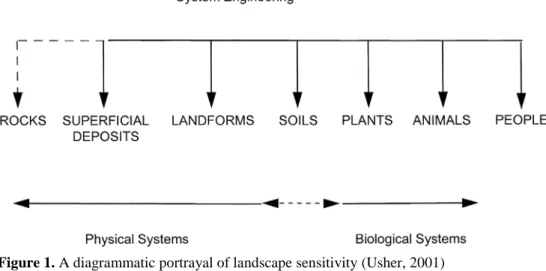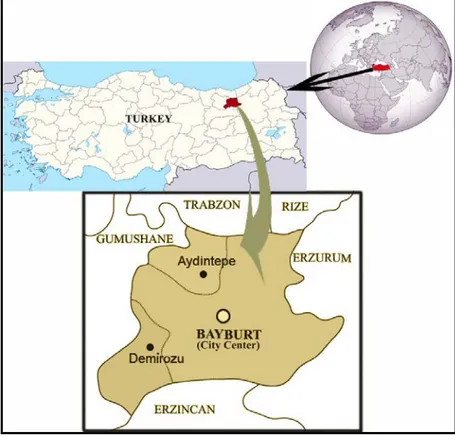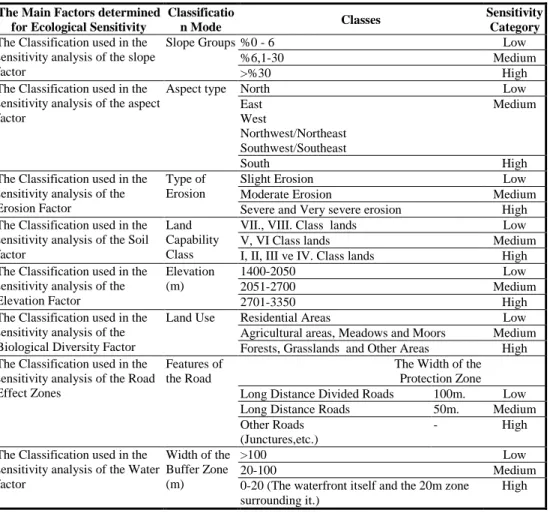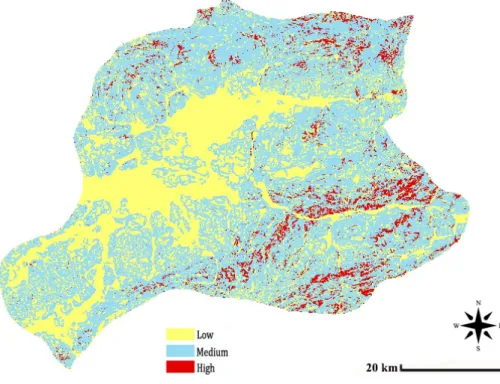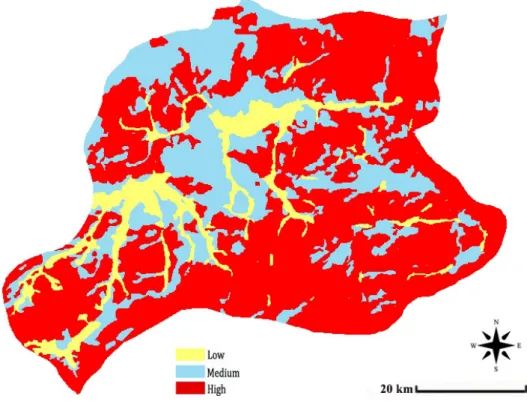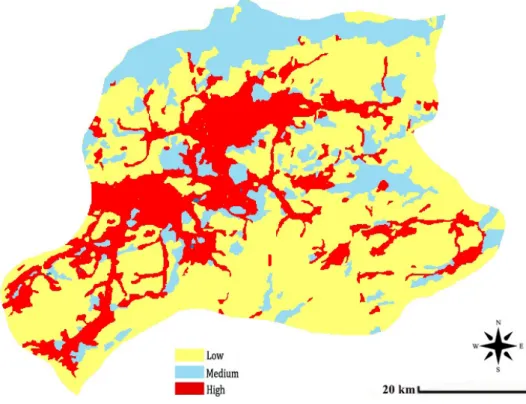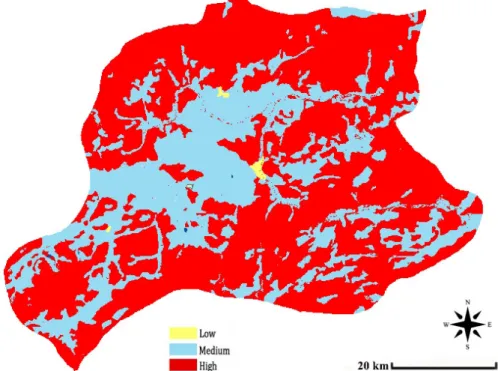BURSA ULUDAĞ ÜNİVERSİTESİ ZİRAAT FAKÜLTESİ DERGİSİ, 2018, Cilt 32, Sayı 2, 77-98 (Journal of Agricultural Faculty of Bursa Uludag University) e-ISSN 2651-4044
http://dergipark.gov.tr/bursauludagziraat; http://www.uludag.edu.tr/ziraatdergi Araştırma Makalesi/Research Article
Sensitivity Analysis in Landscape Ecological Planning;
the Sample of Bayburt
abEsra ÖZHANCI1*, Hasan YILMAZ2
1Hacı Bektaş Veli Üniversitesi Mühendislik-Mimarlık Fakültesi Peyzaj Mimarlığı Bölümü,
Nevşehir, Türkiye,
2
Atatürk Üniversitesi Mimarlık ve Tasarım Fakültesi Peyzaj Mimarlığı Bölümü, Erzurum, Türkiye, *Sorumlu yazar ORCID: 0000-0003-2789-6380
e-posta (Corresponding author e-mail): eozhanci@nevsehir.edu.tr Yazar(lar) ORCID: 0000-0003-3768-4760
e-posta (Author-s e-mail): hyilmaz@atauni.edu.tr
Geliş Tarihi (Received): 08.02.2018; Kabul Tarihi (Accepted): 24.05.2018
Abstract: The components constituting the identity of a landscape are the natural and cultural components. These dynamic and productive systems that constitute landscapes are in constant interaction. Landscape sensitivity is the study of the delineation and protection of sustainable land use. It is the term that represents the dynamic relationships and interactions between the landscape itself and the adjacent artificial elements. According to official statistics, Bayburt province has not been developed much in terms of socio-economic situation and has also decreased in terms of its demographic structure. With this and the accompanying reasons, guidelines were needed for effective landscaping planning and management. The province represents an important reserve for the determination of ecological sensitivity areas because it has a relatively undisturbed rural landscape structure. In this study, the ecological sensitivity zones of the province of Bayburt were defined in order to preserve the natural and cultural assets that the province possesses and to harness them in a rational way. It was aimed to establish an ecologically efficient management model for the region and similar landscapes by demonstrating the effects of human and natural factors on the landscapes. Composite Ecological Sensitivity Map were created by performing an Ecological Sensitivity Analysis. In the light of this analysis, the major part of the province of Bayburt was to have moderately-sensity ecology. In the planning decisions to be made on macro and micro scale, the highly-sensitive areas should be taken as the focus, and the northeastern parts of the province must be preserved in accordance with their susceptibility. In the high-sensitivity areas, on the other hand, the eco-tourism activities should be performed in a limited and controlled manner providing that they become the buffer zones. In the moderately-sensitive parts that constitute the greater part of the area,
a
Bu makale 2010/260 Nolu Atatürk Üniversitesi Bilimsel Araştırma Projesi ile desteklenen doktora
tezinin bir bölümünü içermektedir.
b
Özhancı, E. ve Yılmaz, H. 2018. Ekolojik Peyzaj Planlamasında Duyarlılık Analizi; Bayburt Örneği. Bursa Uludag Üniv. Ziraat Fak. Derg., 32 (2), 77-98.
however, the social, cultural and vital activities which do not cause pressure on the natural landscape are the fields to be sustained in line with the requirements of the modern age.
Keywords: Ecological sensitivity, GIS, Bayburt.
Ekolojik Peyzaj Planlamasında Duyarlılık Analizi;
Bayburt Örneği
Öz: Bir peyzajın kimliğini oluşturan bileşenler, temel doğal ve yapay (kültürel) bileşenlerdir. Peyzajları oluşturan bu dinamik ve üretken sistemler, sürekli etkileşim halindedir. Peyzaj duyarlılığı ise, koruma ve sürdürülebilir alan kullanımı ile ilgili çalışmaların merkezi olmaya devam etmektedir. Düzenli olmayan dinamik sistemler ve değişim ile ilgili bazı kavramları ifade eden bir terimdir. Resmi istatistiklere göre, Bayburt ili sosyo-ekonomik açıdan fazla gelişmemiştir ve demografik yapısı açısından da küçülmüştür. Bu ve eşlik eden nedenlerle, etkili peyzaj planlama ve yönetimi için kılavuzlara ihtiyaç vardır. İl nispeten bozulmamış bir kırsal peyzaj yapısına sahip olması nedeniyle, ekolojik hassasiyet alanlarının belirlenmesi için önemli bir rezervi temsil etmektedir. Bu çalışmada, Bayburt’un sahip olduğu doğal ve kültürel değerlerinin korunması ve rasyonel kullanılması amacıyla, ilin ekolojik duyarlılık zonları tespit edilmiştir. İnsan ve doğal faktörlerin peyzaj üzerindeki etkilerini ortaya koyarak, bölge ve benzer peyzajlar için ekolojik açıdan verimli bir yönetim modeli oluşturulması amaçlanmıştır. Ekolojik Duyarlılık Analizi yapılarak, Toplam Ekolojik Duyarlılık Haritaları (TEDH) ortaya konmuştur. Bu veriler ışığında; Bayburt ilinin büyük bölümünün ekolojik açıdan orta seviyede duyarlı olduğu saptanmıştır. Makro ve mikro ölçekte alınacak planlama kararlarında, duyarlılığı çok yüksek alanlar odak alınarak, ilin kuzeydoğu kesimleri, hassasiyetleri doğrultusunda korunmalıdır. Duyarlılığı yüksek alanlarda ise; tampon zon olması kaydıyla, ekoturizm faaliyetleri sınırlı ve kontrollü bir biçimde gerçekleştirilmelidir. Alanın büyük bölümünü oluşturan orta düzeyde duyarlı kesimlerde ise; doğal peyzaj üzerinde baskı oluşturmayan sosyal, kültürel ve yaşamsal faaliyetler modern çağın gereksinimleri doğrultusunda sürdürülebileceği alanlardır. Anahtar Kelimeler: Ekolojik duyarlılık, CBS, Bayburt.
Introduction
When designing landscape, there are several factors to consider concerning human needs. Natural, physical, social and economic characteristics should be evaluated together in the assessment of quality of outdoor areas (Özhancı et al., 2013). Ecological sensitivity stands for the impact of human interventions on the natural environment (Naujokaitis-Lewis et al., 2009; Liang and Li, 2012). Ecological sensitivity is determined by the reactions of the eco-system to environmental changes caused by external and internal factors (Rossi et al., 2008; Zhang et al., 2012). Complex patterns landscapes can be at different scales, from the unitary and effective homogenous landscape element to the regional landscape based on lithologic or large drainage basin land configurations. Landscapes are dynamic earth systems involving not only objects but also energy and matter reservoirs maintained through growth, decay, flow and transformation (Thomas, 2001). Store et al., (2011) note that landscaping sensitivity includes both the elasticity to change and the ability to recover from change.
For evaluating regional eco-environmental sensitivity extensively it would enable us to determine the priority areas for ecological environmental protection (Rossi et al., 2008; Zhang et al., 2012). A great number of attempts have been made to acknowledge and
identify the relationship between various types of landscape uses. These descriptive attempts include the land system mappings and ecological land classification dating back to 1960s and 1970s (Thomas, 2001).
The quantitative description of the landscape structure forms the basis for defining structural elements in the landscape and enables the modelling process of the ecological impacts. The measurement of a landscape structure is used in the studies on geoinformation technologies (Gardner et al., 2008; Messerli et al., 2009; Riitters et al., 2009; Kelly et al., 2011). The land use and land cover maps created using remote sensing and GIS (geographic information system) allow for the measurement of various characteristics such as landscape heterogeneity, linkage and degradation (Buyantuyev and Wu, 2007; Kelly et al., 2011; Benedek et al., 2011; Gao and Li, 2011).
Landscape structure is characterized by the composition and spatial configuration of the landscape. The composition, represents the variety and the density of the patches in the landscape, regardless of the spatial configuration (Símová and Gdulová, 2012).
Ecological sensitivity, in the science of ecology, used to mean ‘change’ against inertia. Afterwards, in a sample of Scottish plateaus (highlands), it was observed that the type of vegetation changed at a rate of 50% in a 44-year-period of time (Miles et al., 2001). Studies on the sensitivity of a landscape to environmental change are performed for both the natural environment and the effects of the land use on natural systems (Thomas, 2001; Thomas and Allison, 1993).
The existence of the studies and theories as to the components of landscape susceptibility are (Gordon and Sutterland, 1993; Bishop, 1999) not an easy concept to define. The first step is to consider the major natural systems determining landscape structure and the processes affecting these systems. In addition, it is important to define the magnitudes of these changes that have spatio-temporal components (Usher, 2001). In the diagram in Figure 1, the diagrammatic portrayal of landscape sensitivity is defined.
An ecological sensitivity analysis was initially used for estimating the ecological processes and functions likely to get damaged by human induced changes. Most of these studies have focused on the subject of the eco-system sensitivity to acid depositions. After 1990s, the researchers carried out studies regarding the analyses of water-borne soil loss sensitivity, soil erosion sensitivity, land desertification sensitivity and soil salinity (Liang and Li, 2012). Upon understanding the efficiency of sensitivity analyses, a number of studies have been performed on this subject in recent years (Mathys et al., 2006; Coffin, 2007; Hortal and Saura, 2007; Rossi et al., 2008; Mingwu et al., 2010; Símová and Gdulová, 2012; Liang and Li, 2012; Zhang et al., 2012).
In developing countries, regional planning are very important in terms of investments and development. Especially cities which can not gain momentum in terms of economic dynamics and can not come forward with any identity elements are drawing attention and ideas for the development of these cities are presented. In this context, the sample of Bayburt province was selected in the study, aiming to reveal ecological sensitivities and to conduct studies on this axis. The objective of this study was to determine the ecological sensitivity zones of the province of Bayburt in order to preserve its natural and cultural assets of the province; to apply them in a rational way and to aid in making healthy decisions for planning in the future. It was also aimed to establish an ecologically efficient management model for the region and similar landscapes by demonstrating the effects of human and natural factors on the landscapes.
Case Study and Methodology
Case study
With an altitude of between 1400 - 3350 meters, Bayburt is located on the 40o 10’ northern and 40o 15’ eastern longitudes. Bayburt located in the Coruh basin is surrounded by the Soğanlı Mountains in the North, the Otlukbeli Mountains in the South, the Mescit Mountains in the East and the Giresun Mountains in the West (Figure 2). The Bayburt province stands out as a largely intact environment within the region. However, the province is the last rank in terms of economic indicators in the country's rank order. While it is targeted to give direction to Bayburt within development projects and management plans, it is necessary to protect in ecological values and to carry out studies on this axis.
The Ecological Sensitivity Analysis was performed over the related maps and documents about the province of Bayburt. The 1/25 000 –scaled topographic maps of Turkish Rebublic (T.R.) The Ministry of Defense, General Command of Mapping were used for the purpose of producing digital data with respect to land elevation groups, aspect groups, transportation and hydrology (Anonymous 2006). The 1/100 000-scaled land inventory maps acquired from the report of the T.R. Prime Ministry General Directorate of Rural Services, with the title “The Land Size of the Province of Bayburt’’ and dated 1996 were used for the purpose of creating maps of land capability and suitability classes, large land groups, the state of erosion, and the available land uses (Anonymous 1996).
Figure 2. The location map of the study area
Method
Identification of Ecological Sensitivity Criteria
The main and the sub criteria of ecological sensitivity pertaining to this study field were determined by analyzing the sensitivity analysis criteria and scoring methods of Mingwu et al, Vromans et al and Dai et al. (Mingwu et al., 2010; Vromans et al., 2010; Dai et al., 2012).
The main factors determined for ecological sensitivity were selected as slope, aspect, soil class, elevation, eco-system variety, road-effect zone and water.
Organizing Evaluation Classes for Ecological Sensitivity Analysis
Slope factor; The General Directorate of Rural Services classify slope in this way: 0-2% almost flat/plain, 2-6% slightly slope, 6-10-2% moderately slope, 12-20% steep slope, 20-30% very steep slope and 30+% as hilly slope.
Aspect factor; According to Çepel (1988), aspect factor affects the temperature, precipitation and climate of a region. It influences water economy and the composition of vegetation. The northward areas have less water loss, and since snow lasts longer and melts
away slowly, the amount of water infiltrating into the soil is more than that in the southward areas. The northward aspect areas are cooler and shadier, whereas the southward aspect soils are hot and sunny (Erol, 1993; Kiper, 2006). A proper classification of the aspect state for the study field was made by also receiving expert opinions from landscape architecture department.
Erosion factor; Soil erosion is basic concern to balance the use of natural resources against the need for the ecosystem protection (Bayramin et al., 2006). Soil erosion hazard is more severe in Turkey as compared to the other Mediterranean countries (Doğan et al., 2000). Dogan (2011) stated that 14% of land is slightly eroded 20% is moderately eroded and at 63% is severely and very severely eroded in Turkey. Erosion, in the ecological sensitivity grouping and analysis, was reported as slight- moderate- severe and very severe.
Soil factor; Lands were divided into 8 capability classes according to the their possible uses. The classification is ranked according to the suitability level for agriculture (arable areas). The areas in question are ranked between the Ist class in which land has the greatest suitability for agricultural activities since there is no risk of erosion and the 8th class in which the land is inconvenient for any agricultural activities but could provide an environment for wildlife or could be used as a hunting-entertainment area, a tourist place, a settlement area, a recreational area or a national park. While the soils of classes 1-8 constitute the land capability classes within the boundaries of the study field, the 5th class soils cannot be found among these.
Elevation Factor; The province of Bayburt is located in between 1400 m and 3350 m. The more the elevation increases, the more the renewal capacity of nature itself decreases while the number of vulnerable species increases, which enhances the sensitivity. Nature seems static in fact tend to the continuous movement and renewal. The classification of elevation varies with the field of study (Frelich, 2002; Van Der Valk, 2009). A classification of an elevation factor in accordance with the study field was made by also receiving expert opinions from soil science and landscape architecture departments.
Biological diversity factor; Land use at the national and regional scale is an important factor in terms of ecological impacts. The ecological sensitivities of these uses are related to the level of natural elements. If the level of flora and fauna is low, sensitivity is low. The sensitivity levels were determined according to the levels of flora and fauna in the land use types. These land use types are; Residential Areas, Agricultural areas, Meadow and Moors, Forests, Grasslands and Other Areas.
Road-effect zone factor; Pollution from highways and long distance roads can cause harm to the flora and the fauna around them. Some of chemical pollutants in the way only affect the immediate surrounding of the way, others carried a greater distance from the road by wind and water (Coffin, 2007). These impacts are mostly seen in the closest to the road. For this reason, a sensitivity area was created around the roads according to their features (long distance divided roads, long distance roads, other roads etc.). The classification is made according to the road-effect zones (Mingwu et al., 2010)
Water factor; Water sensitivity areas were found around waterfronts, although these areas differe among various studies. Mingwu et al. (2010) described water sensitivity areas as 0-20 m., 20-50 m., 50-100 m, 100-150m and >150m. , using five classes in the analysis.
The classification and sensitivity levels used in the analysis are given in Table 1 for all the factors used for the Ecological Sensitivity Analysis.
Table 1. The Classification used in the Sensitivity Analysis for all the Ecological Sensitivity Factors.
The Main Factors determined for Ecological Sensitivity
Classificatio
n Mode Classes
Sensitivity Category
The Classification used in the sensitivity analysis of the slope factor
Slope Groups %0 - 6 Low
%6,1-30 Medium
>%30 High
The Classification used in the sensitivity analysis of the aspect factor
Aspect type North Low
East West Northwest/Northeast Southwest/Southeast Medium South High
The Classification used in the sensitivity analysis of the Erosion Factor
Type of Erosion
Slight Erosion Low
Moderate Erosion Medium
Severe and Very severe erosion High
The Classification used in the sensitivity analysis of the Soil factor
Land Capability Class
VII., VIII. Class lands Low
V, VI Class lands Medium
I, II, III ve IV. Class lands High
The Classification used in the sensitivity analysis of the Elevation Factor Elevation (m) 1400-2050 Low 2051-2700 Medium 2701-3350 High
The Classification used in the sensitivity analysis of the Biological Diversity Factor
Land Use Residential Areas Low
Agricultural areas, Meadows and Moors Medium
Forests, Grasslands and Other Areas High
The Classification used in the sensitivity analysis of the Road Effect Zones
Features of the Road
The Width of the Protection Zone
Long Distance Divided Roads 100m. Low
Long Distance Roads 50m. Medium
Other Roads (Junctures,etc.)
- High
The Classification used in the sensitivity analysis of the Water factor Width of the Buffer Zone (m) >100 Low 20-100 Medium
0-20 (The waterfront itself and the 20m zone surrounding it.)
High
Creating and Organizing Ecological Sensitivity Maps
The sub units of the evaluation factors were determined according to the ecological structure and regional characteristics of the province of Bayburt. Digital maps were made using the Arc Map program in a GIS medium in accordance with the Bayburt Province sub units. The sub-categories were classified as Low (1 point), Moderate (5 points) and High (10 points) sensitivity levels. These three levels have been transformed into five levels in the latest Map, in order to include intermediate groups formed as a result of overlapping.
The study comprised 1/25 000 – scaled 39 map sections involving the whole province of Bayburt. These maps were converted into the Raster data for the Ecological Sensitivity
Maps created by integrating all the factors. By coinciding these maps with the ArcMap program, The Composite Ecological Sensitivity Map (TESM) was created. Through the “Spatial Analysis” method, the study field was classified as: The Areas Low in Ecological Sensitivity, Areas moderate in Ecological Sensitivity, Areas High in Ecological Sensitivity and The Areas Very High in Ecological Sensitivity.
Findings
In order to show the sensitivity level of the study field, sensitivity maps were created by classifying maps of all the combined factors according to the levels given in the method.
The Evaluation of Slope Sensitivity
According to the slope sensitivity map, 35,19% of the province lands (133.220 ha) had low sensitivity, 59,38% (224.775 ha) moderate sensitivity and 5,43% (20.560 ha) high-sensitivity. The province does not have much of its land in a critically sentive slope. The lowlands (plain areas), The River Çoruh and Çoruh Valley become prominent in this respect.
The slope sensitivity is at high levels in the mountainous areas of the province as expected. The distribution of the ecological sensitivity areas and their proportions within the area according to the slope groups is given in Table 2, while the sensitivity map is given in Figure 3.
Table 2. The distribution of the ecological sensitivity areas and their proportions according to the slope groups.
Sensitivity Category Area (ha) Percentage (%)
Low 133.220 35,19
Medium 224.775 59,38
High 20.560 5,43
Total 378.555 100
The Evaluation of the Aspect Sensitivity
The aspect sensitivity map of the province indicated that 82,73 % (313.175 ha) of the province lands was moderately sensitive, whereas 8,71% (32.984 ha) was high-sensitive (Table 3). The major part of the province of Bayburt is moderately sensitive in terms of the aspect factor. The Northward lands which are low in sensitivity cover a narrow area that extends across the province. Aydıntepe County Town or the residential area of Aslandede Village was among these areas mentioned above (Figure 4).
Table 3. The distribution of the ecological sensitivity areas and their proportions according to the aspect groups.
Sensitivity Category Area (ha) Percentage (%)
Low 32.396 8,56
Medium 313.175 82,73
High 32.984 8,71
Total 378.555 100
The Evaluation of Erosion Sensitivity
The Erosion Sensivity Map indicated that 62,58% (236.902 ha) lands were in high-sensitivity class . Erosion high-sensitivity decrased in areas with an altitude over 1800 m such as the Aydıntepe plain, Dikmetaş plain, Düzeker plain and Mormuş lowland (Table 4, Figure 5).
Table 4. The distribution of the ecological sensitivity areas and their proportions according to the erosion groups.
Sensitivity Category Area (ha) Percentage (%)
Low 38.204 10,09
Medium 103.449 27,33
High 236.902 62,58
Total 378.555 100
The Evaluation of the Soil Sensitivity
The soil sensitivity map showed that 56,98% (215.696 ha) lands were in the low-sensitivity class , while 19,32% (73.123 ha) in moderately-sensitive class (Table 5). It was clear to conclude that a major part of the province has a low-level sensitivity in terms of the land capability classes (Figure 6).
Table 5. The distribution of the ecological sensitivity areas and their proportions according to the soil groups.
Sensitivity Category Area (ha) Percentage (%)
Low 215.696 56,98
Medium 73.123 19,32
High 89.736 23,7
Total 378.555 100
Evaluation of Elevation Sensitivity
The Elevation Sensitivity Map indicated that 68,89% (260.798 ha) lands were in low-sensitive class while 29,20% (110.541 ha) in moderately-low-sensitive class. (Table 6). In this map, the dish-shaped topography of the province is perceived more clearly. In the province of Bayburt, where the lowlands and valleys cover a large area, the elevation sensitivity in the major part of the region is at low levels. On the other hand, the mountainous areas where the valleys rise are sensitive at moderate levels.
The sensitivity level of the mountainous areas situated in the northwest (Mount Yamalıdağ, Komarlık Crest, Haldizendağı Crest, Sarıçiçek Crest, Çataldere Crest, Kızıltoprak Crest, Kayışkıran Crest, Sulakbaşı Crest, Yoncalı Crest, etc.) and southeast of the province (Crest Yedikurunlaryamacı on the Çavuşkıran mountains, Çiftpınar Crest, Kızoğlandağı Crest, Kazdere Crest,etc.) and at 2700 m altitude and above is quite high (Figure 7).
Table 6. The distribution of the ecological sensitivity areas and their proportions according to the elevation groups.
Sensitivity Category Area (ha) Percentage (%)
Low 260.798 68,89
Medium 110.541 29,2
High 7.216 1,91
Total 378.555 100
Evaluation of the Sensitivity of Biological Diversity
The biological diversity map created for measuring biological diversity indicated that 33,86% (128.171 ha) of the land was moderately sensitive, whereas 65,9% (249.472 ha) of it was high-sensitive in this respect (Table 7). The province of Bayburt is highly-sensitive to a great extent in terms of biological diversity. The sensitivity regions were not localized in a certain area but ranged across the province. The mountainous areas in the north where only the agricultural fields show decrease can be perceived more clearly (Figure 8).
Table 7. The distribution of the ecological sensitivity areas and their proportions according to the biological diversity groups.
Sensitivity Category Area (ha) Percentage (%)
Low 912 0,24
Medium 128.171 33,86
High 249.472 65,9
Total 378.555 100
Evaluation of the Sensitivity of Road-effect Zone
In the sensitivity map of the road-effect zone within the province, it was ascertained that 99,28% (375.824 ha) of the area had low-sensitivity in terms of the road-effect zone, whereas 0,32% (1.210 ha) was moderately-sensitive in this respect. On the other hand, 0,40% (1.521 ha) of it was determined to be high-sensitive (Table 8). As is expected, a proportionally small area in the province of Bayburt which embody the surroundings of long distance roads is high-sensitive in terms of road-effect (Figure 9).
Table 8. The distribution of the ecological sensitivity areas and their proportions according to the road-effect zone groups.
Sensitivity Category Area (ha) Percentage (%)
Low 375.824 99,28
Medium 1.210 0,32
High 1.521 0,40
Total 378.555 100
Evaluation of the Water Sensitivity
The transportation map created for describing the water sensitivity level showed that 83,78% (317.151 ha) of the area had low-sensitivity in terms of water, whereas 12,89% (48.796 ha) had moderately-sensitive (Table 9). The water sensitivity in the major part of the province was at low levels. In this map, the regions where there are tributaries(streams), brooks and lakes and their surroundings indicated the areas which are moderately or high-sensitive depending on the zoning levels performed (Figure 10).
Table 9. The distribution of the ecological sensitivity areas and their proportions according to the water classes.
Sensitivity Category Area (ha) Percentage (%)
Low 317.151 83,78
Medium 48.796 12,89
High 12.608 3,33
Total 378.555 100
Evaluation of the Composite Ecological Sensitivity
The Composite Ecological Sensitivity Map (TESM) was created by overlapping all the sensitivity maps with each other in order to put forward the composite ecological sensitivity level of the research field (Table 10, Figure 11).
The TESM ascertained that 7,70% (29.163 ha) of the land had ecologically low-sensitivity, 79,05% (299.264 ha) of it was moderately-sensitive, 13,20 (49.935 ha) was ecologically high-sensitive, whereas 0,05% (193 ha) of it was ecologically very highly sensitive. The major part of the province of Bayburt is ecologically sensitive at moderate levels.
Table 10. The distribution of the ecological sensitivity areas and their proportions.
Sensitivity Category Area (ha) Percentage (%)
Extremely Low 0 0 Low 29.163 7,70 Medium 299.264 79,05 High 49.935 13,20 Extremely High 193 0,05 Total 378.555 100
It was found that some of the areas situated on the mountainous parts and highlands/plateaus, such as Göloba plateau, Sarıçiçek plateau, Armutlu plateau, Ayıtaşı plateau, Beyler boğazı, Pampul plateau, Çataldere plateau, Kayışkıran Crest, Kurşunkaya crest, Kırtazor plateau and Çençül plateau situated in the northwest of the province and some other areas situated over the streams, such as Derin, Gılangın, Yatak, Pelitlik, Sulakdere, Kayaklarındere, Kop, Bendazlı, Yayla and Kılıçkaya were the areas where sensitivity was at very high levels. These regions, which are located in the South of Soğanlı, Haldizen and Kemer mountains and between 2400-2800 m constitute the smallest area in distribution (D) (Figure 12).
(C)
(A) (B)
(D)
Figure 12. Samples according to the sensitivity levels on the Composite Ecological Sensitivity Map (A: Düzeker plain (1500 m and around)/ Low-sensitive, B: Karşıgeçit village (1465 m)/ moderately-sensitive, C: The northwest of Çalıdere village, Gülsincan (2211 m) and Gosu (2111 m) hills / High-sensitive, D:Çençül Plateau /Highly (very) sensitive)
The high sensitive areas were largely located in the region surrounding these areas and mainly in the higher parts of the region in the southeast of the province located on the same longitudes (C).
The moderately-sensitive areas, however, mainly distributed around the central zone and the southwestern part of the province. In general, these areas appeared as the plain or northward areas where the elevations join the lowland (B).
The low-sensitive areas which were ranked in the second row spatially, were localized in the regions close a lowland and plain where the elevation rised up to 1800 m at most and the erosion sensitivity diminished a great deal (Aydıntepe plain (lowland), Düzeker plain, Hasan plain, Mormuş prairie, Cünüt prairie, Gevrek prairie, Küllüler prairie, Hasan prairie, Örenler prairie, Karaçayır prairie, Çorak prairie, Dikmetaş plain). In addition, the major part of the center of Bayburt, Aydıntepe and Demirözü were the areas where sensitivity iwas at low levels (A).
Discussion
Understanding the landscape change with short and long periodic geomorphologic stresses depends on the behavior of the landscape when changing system resistances and / or inputs (Souza et al, 2015).
In this study, the sensitivity evaluation was largely fictionalized in terms of the natural and cultural landscape components through the parameters applied and the assessments performed in the sensitivity analysis. According to the results obtained, the most sensitive areas can be planning as the core protection area. With this type of planning, the area can be protected from human degradation. Highly-sensitive areas, the largest part of which exists around this area and across the province can be planned as the buffer zone. With this planning, the current state of the areas in question can be preserved within the frame of protection and utilization in balance and can be evaluated on the basis of ecological, nature-oriented and recreational/touristic activities. The areas where sensitivity is the lowest can be planned as the field of socio-economic activities of the province.
The ecosystems existing in the high-sensitivity zones are susceptible to damage and should be defined as the key areas for protection and restoration (Liang and Li, 2012). The planning of areas of sensitivity is summarized in Table 11.
Table 11. The planning table for sensitivity areas
Sensitivity areas Planning Advantages and disadvantages Extremely High
Sensitivity areas
The most sensitive areas can be considered as the core protection area.
With this type of planning, the area can be protected from human degradation. It requires high precision.
High Sensitivity areas
Highly-sensitive areas, the largest part of which exists around this area and across the city can be planned as the buffer zone
With this planning, these areas can be evaluated on the basis of ecological, nature-oriented and recreational/touristic activities. The nature and possible effects of use should be carefully examined.
Moderately-sensitivity areas
These areas can be used as vital areas with the continuation of existing activities.
It has the sensitivity of urban use.
Possible deterioration in the long term must be checked.
Low Sensitivity areas
These areas can be planned as the field of socio-economic activities of the city.
Providing the basis for industrial development activities and industrial organizations. The environmental impact must be kept under control.
From the point of view of the results, the study has developed in the expected direction. In terms of analysis, more minimal selection of the study area will allow more detailed and point-to-point evaluations. It will be possible to do more detailed planning on this site.
Conclusion
In the light of all these results and observations, the prominent suggestions are listed below:
• In the planning decisions to be made on a macro and micro scale, the highly-sensitive areas should be taken as the focus, and the northeastern parts of the province must be preserved in accordance with their susceptibility. These sensitive areas must be prioritized by protecting the landscape value.
• In the high-sensitivity areas, on the other hand, the eco-tourism activities should be performed in a limited and controlled manner providing that they become the buffer zones. With these eco-tourism activities that are extremely sensitive to Nature, these areas should both be protected in an ideal way and become an asset for the economy of the province and the country in this way.
• In the moderately-sensitive parts that constitute the greater part of the area, however, the social, cultural and vital activities which do not cause pressure on the natural landscape are the fields to be sustained in line with the requirements of the modern age.
• The rural settlements situated within this zone must be visually and aesthetically improved. Thus, in 2013, The Ministry of Environment and Urbanisation had 15 types of architectural project prepared for the Western, Mid- and Eastern Black Sea villages and provided 5000 TL support to those who built their homes in accordance with these projects. The study to be conducted through the governorates and district governorships will contribute in terms of the local/regional architecture.
• The remarkable intact rural structure and the pure culture of the province of Bayburt should be evaluated accurately. There is no doubt that Bayburt is a province that requires developments and changes of urban and socio-economic structure. However, the rural areas should be supported and evaluated prior to these developments.
References
Anonymous, 1996. Gümüşhane ili arazi varlığı. T.C. Başbakanlık Köy Hizmetleri Genel Müd. Yayınları, Ankara.
Anonymous, 2006. Milli Savunma Bakanlıgı Harita Genel Komutanlıgı 1/25000 ölçekli ve 2006 tarihli topografik haritalar, Ankara.
Bayramin, Ü., Erpul, G., Erdoğan H. E., 2006. Use of CORINE Methodology to Assess Soil Erosion Risk in the Semi-Arid Area of Beypazarı, Ankara. Turk. J. Agric. For., 30, 81-100.
Benedek, Z., Nagy, A., Rácz, I. A., Jordán, F., Varga, Z. 2011. Landscape metrics as indicators: quantifying habitat network changes of a bush-cricket Pholidoptera transsylvanica in Hungary. Ecological Indicators, 11, 930-933.
Bishop, I.D., 1999. Modelling the view: perception and visualisation. In: Usher, M.B. Ed., Landscape Character: Perspectives on Management and Change. The Stationery Office, Edinburgh, 150–161.
Buyantuyev, A., Wu, J. 2007. Effects of thematic resolution on landscape pattern analysis. Landscape Ecology, 22, 7-13.
Coffin, A.W., 2007. From roadkill to road ecology: A review of the ecological effects of roads. Journal of Transport Geography, 15, 396–406.
Çepel, N. 1988. Orman topraklarının karakteristikleri, toprak olusumu özellikleri ve ekolojik bakımdan degerlendirilmesi. stanbul Ün. Toprak İlmi Ders Kitabı, Yayın No: 3416, Ofset Yayın No: 389, İstanbul.
Dai, X., Li, Z., Lin, S., Xu, W., 2012. Assessment and zoning of eco-environmental sensitivity for a typical developing province in China. Stoch Environ Res Risk Assess, 26:1095–1107. Doğan, O., 2011. Türkiye’de Erozyon Sorunu Nedenleri ve Çözüm Önerileri, Bilim ve Aklın
Aydınlığında Eğitim, 62-69.
Doğan, O., Küçükçakar, N., Özel M.E., and Yıldırım, H., 2000. Erosion risk mapping of Dalaman Basin located in West Mediterranean Region using Corine method. In International Symposium on Desertification, Konya, Turkey.
Erol, O., 1993. Türkiyenin Dogal Yöre ve Çevreleri. Ege Cografya Dergisi 7, 13-41, İzmir.
Frelich, L. E., 2002. Forest Dynamics and Disturbance Regimes Studies from Temperate Evergreen– Deciduous Forests, p 278, Cambridge University Press, New York.
Gao, J., Li, S., 2011. Detecting spatially non-stationary and scale-dependent relationships between urban landscape fragmentation and related factors using geographically weighted regression. Applied Geography, 31(1), 292-302.
Gardner, R. H., Lookingbill, T. R., Townsend, P. A., Ferrari, J. 2008. A new approach for rescaling land cover data. Landscape Ecology, 23, 513-526.
Gordon, J.E., Sutherland, D.G., 1993. Quaternary of Scotland. Chapman and Hall, London.
Hortal, P. L., Saura, S., 2007. Impact of spatial scale on the identification of critical habitat patches for the maintenance of landscape connectivity. Landscape and Urban Planning, 83, 176– 186.
Kelly, M., Tuxen, K. A., Stralberg, D., 2011. Mapping changes to vegetation pattern in a restoring wetland: finding pattern metrics that are consistent across spatial scale and time. Ecological Indicators, 11, 263-273.
Kiper, T., 2006. Safranbolu Yörükköyü peyzaj potansiyelinin Kırsal turizm açısından değerlendirilmesi. Ankara Üniv. Fen Bilimleri Enst., Doktora Tezi.
Liang, C., Li, X., 2012. The Ecological Sensitivity Evaluation in Yellow River Delta National Natural Reserve. Clean – Soil, Air, Water, 40 (10), 1197–1207.
Mathys, L., Ginzler, C., Zimmermann, N.E., Brassel, P., Wildi, O., 2006. Sensitivity assessment on continuous landscape variables to classify a discrete forest area. Forest Ecology and Management, 229, 111–119.
Messerli, P., Heinimann, A., Epprecht, M. 2009. Finding homogeneity in heterogeneity e a new approach to quantifying landscape mosaics developed for the Lao PDR. Human Ecology, 37, 291-304.
Miles J, Cummins R P, French D D, Gardner S, Orr J L andShewry M C 2001 Landscape sensitivity: an ecological view. Catena, 42, 124– 41.
Mingwu, Z., Haijiang J., Desuo C., Chunbo J., 2010. The Comparative Study on The Ecological Sensitivity Analysis in Huixian Wetland, China. Procedia Environmental Science; 2: 386-398.
Naujokaitis-Lewis, I. R., Curtis, J. M. R., Arcese, P., Rosenfeld, J., 2009. Sensitivity Analyses of Spatial Population Viability Analysis Models for Species at Risk and Habitat Conservation Planning, Conserv. Biol., 23 (1), 225–229.
Özhanci, E., Yilmaz, H., Yilmaz, S., 2013. Safety perception of different plant designs in pedestrian and car streets. Urban design international, 19(4), 303–310.
Riitters, K. H., Vogt, P., Soille, P., Estreguil, C., 2009. Landscape patterns from mathematical morphology on maps with contagion. Landscape Ecology, 24, 699-709.
Rossi, P., Pecci, A., Amadio, V., Rossi, O., Soliani, L., 2008. Coupling Indicators of Ecological Value and Ecological Sensitivity with Indicators of Demographic Pressure in the Demarcation of New Areas to be Protected: The Case of the Oltrepo Pavese and the Ligurian- Emilian Apennine Area (Italy), Landscape Urban Plann., 85 (1), 12–26.
Símová, P., Gdulová, K., 2012. Landscape indices behavior: A review of scale effects. Applied Geography 34, 385-394.
Souza, P., Otaviano, J., Correa, B., Carlos, A., 2015. Landscape Sensitivity Analysis in The Saco Creek Watershed – Pe. Revista Brasileira De Geomorfologia, 16 (4), 615-630.
Store, R. Karjalainen, E., Haara, A., Leskinen, P., Nivala V., 2015. Producing a sensitivity assessment method for visual forest landscapes. Landscape and Urban Planning, 144, 128–141. Thomas, D.S.G., Allison, R.J., 1993. Landscape Sensitivity. Wiley, Chichester.
Thomas, M.F., 2001. Landscape sensitivity in time and space — an introduction. Catena, 42, 83–98. Usher, M.B., 2001. Landscape sensitivity: from theory to practice. Catena 42, 375–383.
Van der Valk, A.G., (Edt.) 2009. Forest Ecology, Recent Advances in Plant Ecology, 358, Springer. Vromans, D.C., Maree, K.S., Holness, S., Job, N., Brown, A.E., 2010. The Garden Route Biodiversity
Sector Plan for the Southern Regions of the Kouga and Koukamma Municipalities: Supporting Land-use Planning and Decision-making in Critical Biodiversity Areas and Ecological Support Areas for Sustainable Development. Garden Route Initiative, South African National Parks, Knysna.
Zhang, J., Xiang, C., Li, M., 2012. Integrative Ecological Sensitivity (Ies) Applied to Assessment of Eco-Tourism İmpact On Forest Vegetation Landscape: A Case from The Baihua Mountain Reserve of Beijing, China. Ecological Indicators, 18, 365–370.
